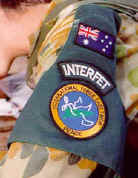While the deeds of our original ANZAC heroes are long past, their spirit continues to live on through the more recent efforts of Australian troops in East Timor. The spirit of ANZAC is described by official war historian C.E.W. Bean as "enterprise, resourcefulness, fidelity, comradeship and endurance". These same qualities have also been attributed to our troops who served in East Timor.
The latest deployment was not the first time Australian soldiers have operated in East Timor. In December 1941 Japan entered World War 2 by invading Malaya, the Indonesian Archipelago and the south Pacific. Australia sent a small force, known as Sparrow Force, to defend the island of Timor. Despite a spirited campaign most of the Australians were forced to surrender. One group, however, were not captured and continued the fight. They relied heavily on support from the Timorese and a strong relationship seems to have developed. The indigenous people of East Timor were more supportive of the Australians than the West Timorese, a result of the different treatment they received from the Dutch and Portuguese. Later reinforcements had a less close relationship as the Japanese were intent on terrorising the local people to force them to stop helping the Australians. Fighting guerrilla warfare and dependent on local support, the Australians harassed the large Japanese force for nearly a year, until withdrawn. A small group of commandos remained active in the area for the rest of the war. As many as 60,000 East Timorese were killed during the conflict.
Our most recent military involvement in East Timor began in 1999 when the East Timorese people were given the opportunity to vote on whether or not they wanted their independence from Indonesia. The world watched in horror at the violence unleashed when the people chose to become independent. Images and reports of fighting, looting, arson and even murder committed by pro-Indonesian militias and Indonesian troops were beamed around the world.

The United Nations authorised an international force to enter the country. Its task was to provide protection and security to the local people. On 12 September 1999 Australian troops joined those from other nations to provide that security and allow the local people to begin rebuilding their lives and their new nation. The Australian-led International Force in East Timor comprised at its height 6300 troops.
InterFET as it became known was headed by an Australian officer, Major General Peter Cosgrove. He was surprised to find there were still a number of people living in the region who remembered the Australian presence on the island during World War 2. General Cosgrove said he was pleased to be able to pay them back a little of the "debt of honour" that Australia owed the Timorese people for risking their lives to help Australian soldiers nearly sixty years ago.
"I have also discovered that the spirit of ANZAC lives on," he said. "It is one that permeates all Australians and not just ones in uniform. It is the innate Australian quality of wishing everyone could get a fair go."
Australian Prime Minister John Howard summed up the spirit of the Australian troops when he gave an address to the nation in September 1999 as they departed.
"Our soldiers go to East Timor as part of a great Australian military tradition which has never sought to impose the will of this country on others but only to defend what is right," he said.
In February 2000, after several months of helping to restore order and security, InterFET handed over much of its role to a United Nations force. The UN Transitional Administration East Timor, UNTAET, will continue to administer the territory for another two years.





